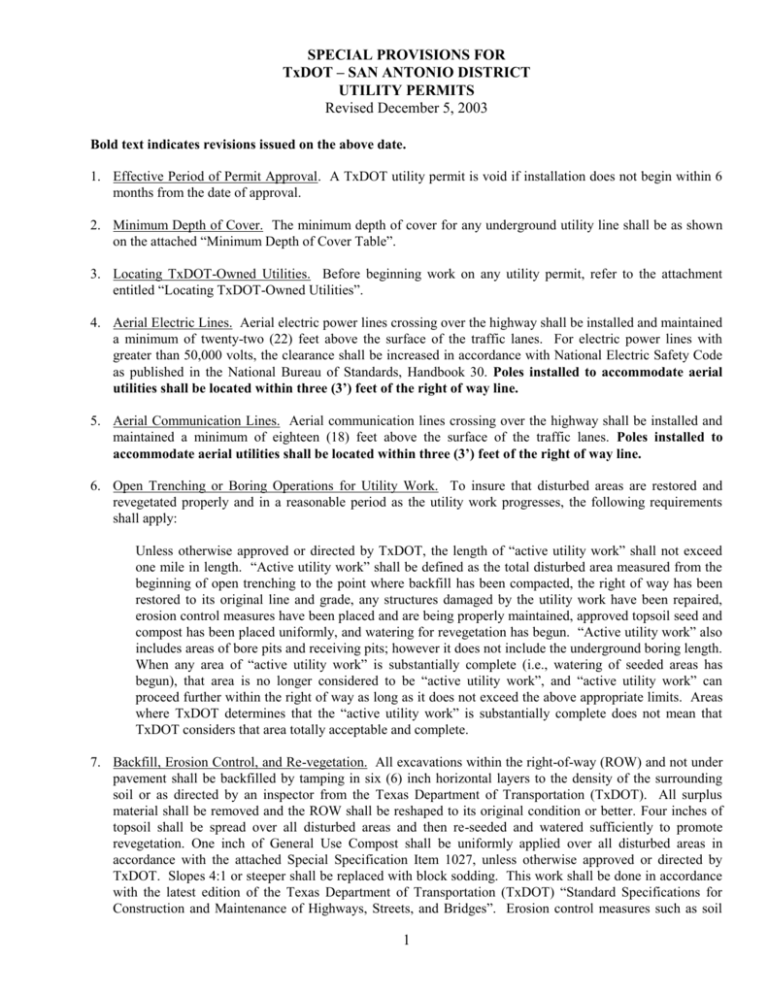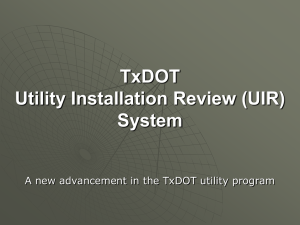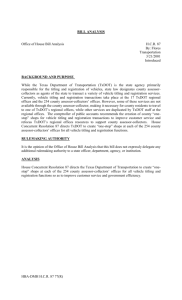utilsppv - the Texas Department of Transportation FTP Server
advertisement

SPECIAL PROVISIONS FOR TxDOT – SAN ANTONIO DISTRICT UTILITY PERMITS Revised December 5, 2003 Bold text indicates revisions issued on the above date. 1. Effective Period of Permit Approval. A TxDOT utility permit is void if installation does not begin within 6 months from the date of approval. 2. Minimum Depth of Cover. The minimum depth of cover for any underground utility line shall be as shown on the attached “Minimum Depth of Cover Table”. 3. Locating TxDOT-Owned Utilities. Before beginning work on any utility permit, refer to the attachment entitled “Locating TxDOT-Owned Utilities”. 4. Aerial Electric Lines. Aerial electric power lines crossing over the highway shall be installed and maintained a minimum of twenty-two (22) feet above the surface of the traffic lanes. For electric power lines with greater than 50,000 volts, the clearance shall be increased in accordance with National Electric Safety Code as published in the National Bureau of Standards, Handbook 30. Poles installed to accommodate aerial utilities shall be located within three (3’) feet of the right of way line. 5. Aerial Communication Lines. Aerial communication lines crossing over the highway shall be installed and maintained a minimum of eighteen (18) feet above the surface of the traffic lanes. Poles installed to accommodate aerial utilities shall be located within three (3’) feet of the right of way line. 6. Open Trenching or Boring Operations for Utility Work. To insure that disturbed areas are restored and revegetated properly and in a reasonable period as the utility work progresses, the following requirements shall apply: Unless otherwise approved or directed by TxDOT, the length of “active utility work” shall not exceed one mile in length. “Active utility work” shall be defined as the total disturbed area measured from the beginning of open trenching to the point where backfill has been compacted, the right of way has been restored to its original line and grade, any structures damaged by the utility work have been repaired, erosion control measures have been placed and are being properly maintained, approved topsoil seed and compost has been placed uniformly, and watering for revegetation has begun. “Active utility work” also includes areas of bore pits and receiving pits; however it does not include the underground boring length. When any area of “active utility work” is substantially complete (i.e., watering of seeded areas has begun), that area is no longer considered to be “active utility work”, and “active utility work” can proceed further within the right of way as long as it does not exceed the above appropriate limits. Areas where TxDOT determines that the “active utility work” is substantially complete does not mean that TxDOT considers that area totally acceptable and complete. 7. Backfill, Erosion Control, and Re-vegetation. All excavations within the right-of-way (ROW) and not under pavement shall be backfilled by tamping in six (6) inch horizontal layers to the density of the surrounding soil or as directed by an inspector from the Texas Department of Transportation (TxDOT). All surplus material shall be removed and the ROW shall be reshaped to its original condition or better. Four inches of topsoil shall be spread over all disturbed areas and then re-seeded and watered sufficiently to promote revegetation. One inch of General Use Compost shall be uniformly applied over all disturbed areas in accordance with the attached Special Specification Item 1027, unless otherwise approved or directed by TxDOT. Slopes 4:1 or steeper shall be replaced with block sodding. This work shall be done in accordance with the latest edition of the Texas Department of Transportation (TxDOT) “Standard Specifications for Construction and Maintenance of Highways, Streets, and Bridges”. Erosion control measures such as soil 1 SPECIAL PROVISIONS FOR TxDOT – SAN ANTONIO DISTRICT UTILITY PERMITS Revised December 5, 2003 retention blankets, rock berms, and silt fences shall be installed and maintained until permanent perennial vegetation is established over 70% of the disturbed area. The amount of revegetation is considered acceptable when it resembles the amount of existing vegetation in the surrounding undisturbed area. 8. Boring and Jacking. Boring and jacking of utility lines shall be provided as specified below. a. Under Highways. Utility lines to be constructed under any TxDOT highway shall be installed by boring and jacking with steel casing. Boring shall extend a minimum of ten (10) feet from the edge of pavement or curb. Use of water or other fluids in connection with boring operations will be permitted only in sufficient quantity to lubricate the boring bit and provide a smooth flow of cuttings. Jetting will not be permitted. b. Under Paved County Roads or City Streets. Utility lines to be constructed under an existing paved (asphalt pavement or concrete pavement) county road or city street intersection at a TxDOT Highway, shall be installed by boring and jacking with steel casing. c. Under Paved Driveways. Utility lines to be constructed under existing paved (asphalt pavement or concrete pavement) driveways shall be installed by boring and jacking methods, unless the utility company furnishes TxDOT with a “Letter of No Objection” signed by the driveway owner to allow open cutting of their driveway. d. Under Unpaved County Roads, City Streets, or Driveways. Utility lines to be constructed under an existing unpaved county road or city street intersection at a TxDOT Highway, or under existing unpaved driveways may be open cut after the driveway owner is notified. e. Under Desirable Trees. To preserve the natural environment and protect wildlife habitat, boring may be required when underground utility lines are to be placed within the “protected root area” of “desirable trees” located within highway ROW or on adjacent property. The “protected root area” is defined as the area between the tree trunk and five (5) feet from the tree trunk or 2/3 the actual distance from the tree trunk to the dripline, whichever is greater. “Desirable trees” include (but are not limited to) any tree with a trunk diameter of six (6) inches or more that TxDOT determines to be of environmental and aesthetic value. Boring under all “desirable trees” will be required with the following exceptions: (1) in areas where planned highway construction/maintenance work would require tree removal, or (2) when the TxDOT inspector approves of open trenching for the utility installation or removal of the tree. 9. Manhole Covers. All manhole covers shall be installed flush with the ground surface. 10. Traffic Control. Traffic control in utility work zones shall conform to applicable requirements of the “Texas Manual on Uniform Traffic Control Devices for Streets and Highways, Part VI”. Adequate signs, barricades, flag personnel, etc. shall be erected and maintained in complete compliance with the Texas Manual on Uniform Traffic Control Devices as deemed necessary by the TxDOT inspector. Any travel lane closures are only permitted after a traffic control plan is approved by TxDOT prior to beginning any construction activities. 11. Saturday, Sunday or Holiday Work. Saturday, Sunday or Holiday work will not be permitted for the installation of any utility line unless directed or approved by TxDOT. 2 SPECIAL PROVISIONS FOR TxDOT – SAN ANTONIO DISTRICT UTILITY PERMITS Revised December 5, 2003 12. Protection of Trees and Landscaping. Existing trees and landscaping within the ROW shall be protected as specified below. Removal of trees from the ROW will require prior TxDOT approval. a. Tree Pruning. All tree pruning within the ROW will require prior TxDOT approval. All oak trees that are damaged or pruned shall be treated with an approved tree wound dressing within 20 minutes of causing the damage or making the pruning cut. b. Landscaping. When existing landscaping is located near the proposed utility alignment, the utility contractor shall notify TxDOT and the owner of the landscaping prior to the proposed utility installation. TxDOT may require underground utilities to be installed by: (1) boring under such landscaping or (2) by replacement of specific landscape items. Landscaping is defined as, but not limited to, trees, shrubs, grass, irrigation lines, landscape pavers, sidewalks, and other ROW improvements. C:\UtilitySpecialProvisions 3







